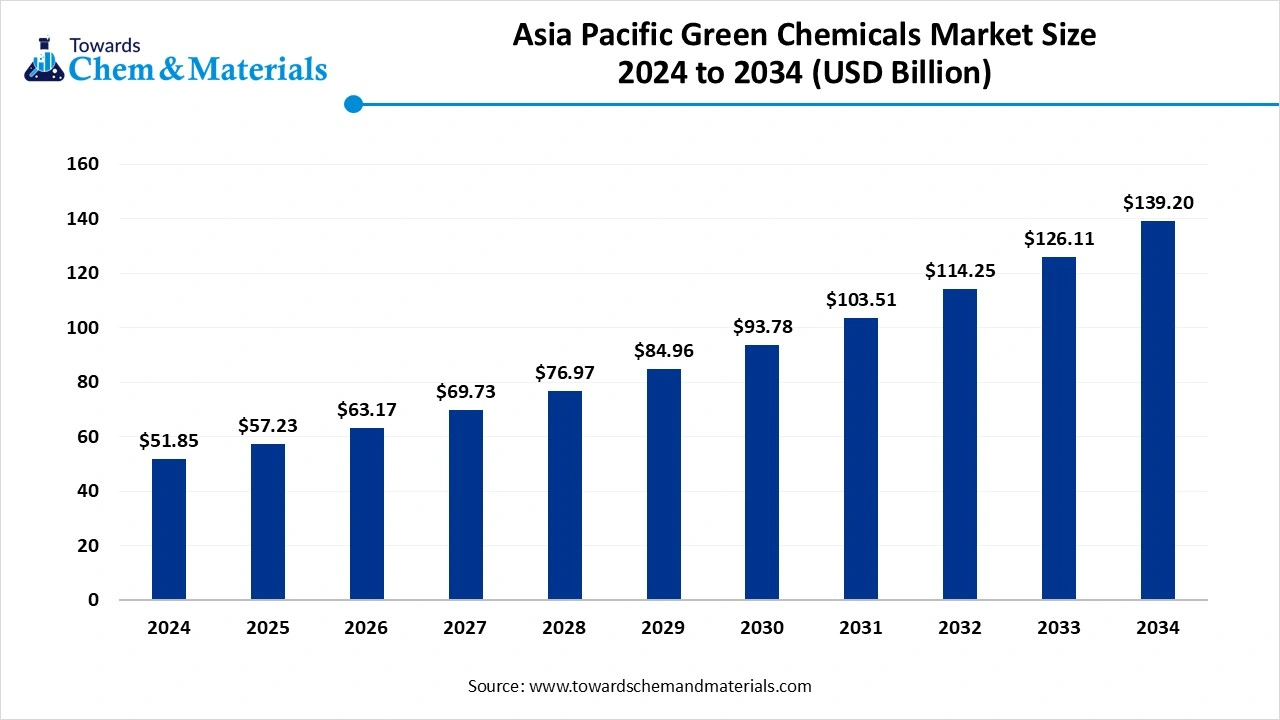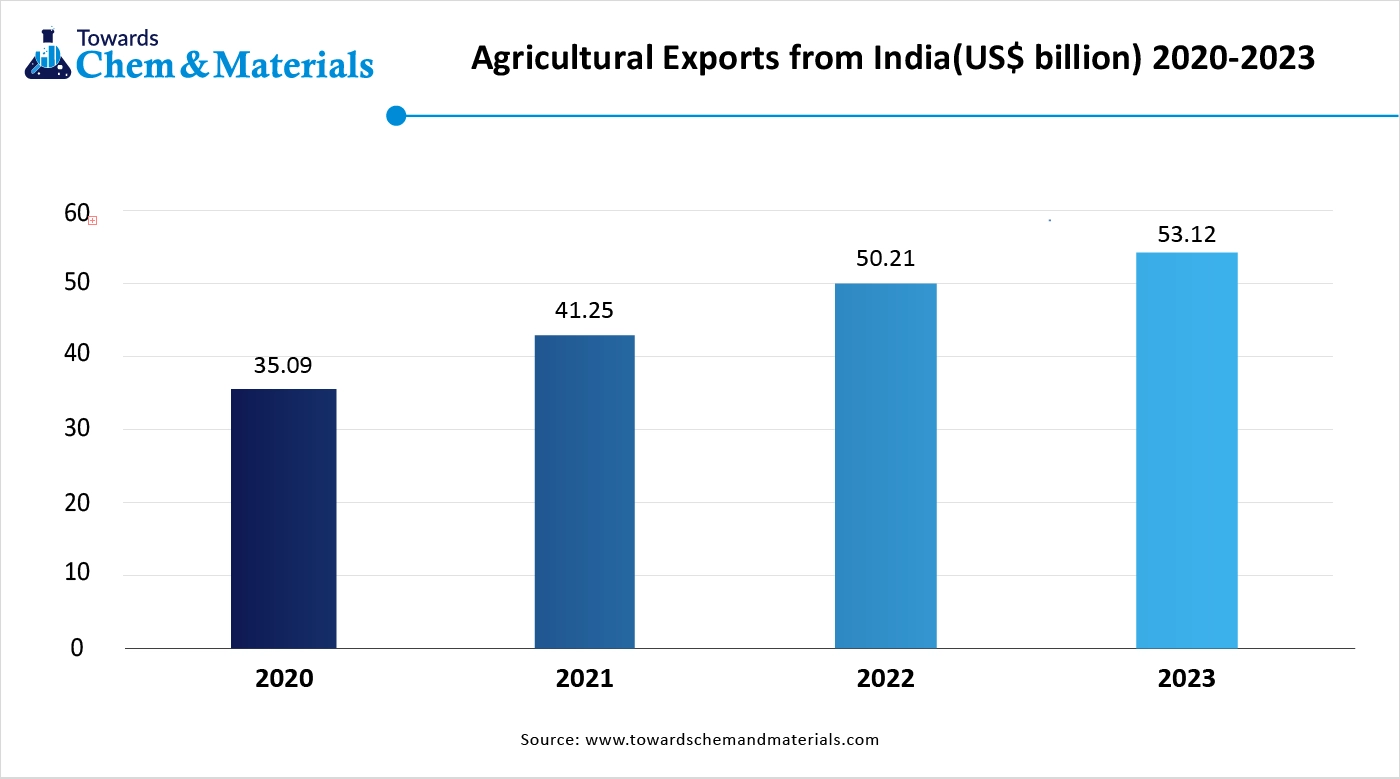November 2025
The Asia Pacific green chemicals market size was valued at USD 51.85 billion in 2024 and is expected to hit around USD 139.20 billion by 2034, growing at a compound annual growth rate (CAGR) of 10.38% over the forecast period from 2025 to 2034. The growing industrial activities and rising awareness about environmental issues drive the market growth.

Asia Pacific green chemicals market growth is driven by supportive government policies, growing industrial activities, focus on sustainability, rising environmental concerns, and the growing agriculture & automotive industries.
Green chemicals are bio-based chemicals manufactured using environmentally friendly methods to reduce the generation of toxic substances and enhance environmental protection. They offer characteristics like renewable sourcing, safer handling, lower hazards, and minimizing waste. Green chemicals offer benefits like sustainable innovation, environmental protection, and enhanced safety.
Technological advancements are transforming the market with the integration of artificial intelligence (AI). The significant integration optimizes chemical processes, minimizes waste, and lowers environmental issues. AI enables faster material discovery, sustainable solvent selection, and the discovery of catalysts. AI helps in process optimization, supply chain optimization, and predictive maintenance during the manufacturing process.
| Report Attributes | Details |
| Market Size in 2025 | USD 57.23 Billion |
| Expected Size by 2034 | USD 139.20 Billion |
| Growth Rate from 2025 to 2034 | CAGR 10.38% |
| Base Year of Estimation | 2024 |
| Forecast Period | 2025 - 2034 |
| Segment Covered | By Product Type, By Application, By Source Type, |
| Key Companies Profiled | ADM (Archer Daniels Midland Company), Evonik Industries AG, Merck KGaA, Solugen, NatureWorks LLC, TotalEnergies Corbion, Toray Industries Inc., Teijin Limited, Kaneka Corporation, Indorama Ventures, Reliance Industries Ltd, Lotte Chemical, FKuR Kunststoff GmbH, Braskem, Syensqo |
| Country / Region | Regulatory Body | Key Regulations | Key Regulations |
| India |
|
|
|
| China |
|
|
|
| Japan |
|
|
|
| South Korea |
|
|
|
Growing Agriculture Sector Drives Market Expansion
The rise in population and a strong focus on food security increase demand for green chemicals. The increasing adoption of precision agriculture techniques and the rise in organic farming increase the adoption of green chemicals. The intensive farming techniques and rising demand for food require green chemicals. The sustainable farming practices and government support for eco-friendly agrochemicals require green chemicals.
The growing expansion of the farming sector and the high need for crop protection require green chemicals. The strong government support for sustainable agricultural practices and increasing demand for organic products increase the adoption of green chemicals. The development of bio fertilizers and biopesticides requires green chemicals. The growing agriculture sector creates an opportunity for the growth of the Asia Pacific green chemicals market.

High Production Cost Shuts Down Market Growth
Despite several benefits of the Green Chemicals in the Asia Pacific, the high production cost restricts the market growth. Factors like large-scale manufacturing facilities, regulatory hurdles, fluctuations in feedstock prices, the need for specialized equipment, and manufacturing complexity are responsible for the high production cost.
The fluctuating prices of feedstocks like agricultural residue, biomass, & food processing waste, and the development of large-scale infrastructure, increase the cost. The high investment in research & development of green chemicals and a skilled workforce requires a high cost. The stricter regulations and traditional manufacturing processes increase the cost. The high production cost hampers the growth of the Asia Pacific green chemicals market.
Why the Bio-Alcohols Segment is Dominating the Asia Pacific Green Chemicals Market?
The bio-alcohols segment dominated the market with a 38% share in 2024. The growing demand for industrial solvents across industries like cosmetics & pharmaceuticals increases demand for bio-alcohols. The strong focus on lowering carbon footprints and stricter environmental regulations increases the adoption of bio-alcohols. The presence of abundant feedstock and a strong focus on sustainable production increases the manufacturing of bio-alcohols like biobutanol & bioethanol, driving the overall growth of the market.
The biopolymers segment is the fastest-growing in the market during the forecast period. The growing concerns about plastic waste and increasing adoption of eco-friendly products increase demand for biopolymers. The increasing development of sustainable packaging solutions and the rising demand for consumer goods increase the adoption of biopolymers. The growing agriculture sector and expansion of the food & beverage industry require biopolymers, supporting the overall market growth.
Which Application Held the Largest Share in the Asia Pacific Green Chemicals Market?
The construction segment held the largest revenue share of 28% in the market in 2024. The growing development of infrastructure projects like metro systems, roads, and bridges increases the adoption of green chemicals. The strong government support for smart cities and the rise in the construction of residential projects require green chemicals. The adoption of green buildings and the high development of commercial spaces require green chemicals, driving the overall growth of the market.
The automotive segment is experiencing the fastest growth in the market during the forecast period. The shift towards electric vehicles and a strong focus on minimizing vehicle weight increases the adoption of green chemicals for the development of lightweight materials. The development of interior components of vehicles like interior trims, seat foams, dashboards, and door panels requires green chemicals like biopolymers. The increasing automotive manufacturing and development of fuel-efficient vehicles drive the market growth.
How the Biomass Segment Dominated the Asia Pacific Green Chemicals Market?
The biomass segment dominated the market with a 70% share in 2024. The low cost of raw materials and focus on waste reduction increase demand for biomass. The increasing production of bio-organic acids, bio-alcohols, and bio-polymers increases demand for biomass. The growing expansion of the packaging industry and increasing adoption of sustainable products require biomass, driving the overall market growth.
The agricultural waste & residue segment is the fastest-growing in the market during the forecast period. The abundance of agricultural waste and the rising demand for sustainable raw materials help the market growth. The high volume of agricultural residues like leaves, stalks, & husks increases the production of green chemicals. The increasing manufacturing of bio-organic acids, biofuels, and bio-polymers requires agricultural waste & residue, supporting the overall market growth.
China is a major contributor to the market. The strong government support for green industrial policy and high investment in green chemical technologies help the market growth. The increasing industrial activities and rising consumer awareness about environmental issues increase demand for green chemicals. The increasing construction activities and rising adoption of vehicles require green chemicals. The development of large projects like biomass-based chemical production drives the market growth.
India: Heart of Asia Pacific’s Green Chemicals Market Expansion
India is growing in the Asia Pacific green chemicals market. The growing production of sustainable products and strong government support for domestic chemical manufacturing increase demand for green chemicals. The increasing adoption of green chemistry principles and high investment in the development of green chemical solutions help market growth. The national green hydrogen mission and a strong focus on sustainable chemical production support the overall market growth.
By Product Type
By Application
By Source Type
November 2025
November 2025
November 2025
November 2025